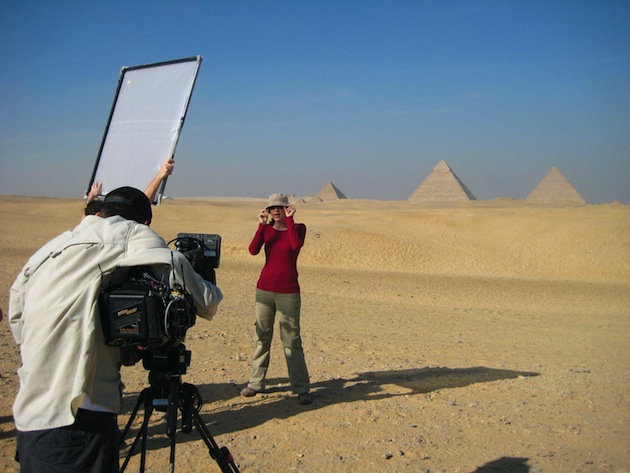The Forgotten Pharoah
In her new book on the pharaoh Hatshepsut, Egyptologist Kara Cooney, BA ’94, argues that history isn’t kind to strong female leaders.
Pop quiz: How many female world leaders can you name? Perhaps Margaret Thatcher, Hillary Clinton, and Angela Merkel come to mind. Most likely Hatshepsut does not—and Kara Cooney wants to change that.
Cooney is an archaeology professor at UCLA and the author of The Woman Who Would Be King, a bestselling new biography of the Egyptian woman who ascended to the throne in 1478 BC. Hatshepsut was only the second female pharaoh in ancient Egypt, and she had a long and prosperous reign. But just decades after her death, nearly all evidence of her work was erased and forgotten. Male pharaohs took credit for her accomplishments, and Hatshepsut has been obscure ever since. “Who doesn’t want to take credit for job creation and temple-building?” Cooney says. “Her success was a detriment in the long run.”
Kara Cooney spoke with the Alcalde about Hatshepsut, life as an Egyptologist, and how her Houston high school piqued her interest in archaeology.
The Alcalde: What are some misconceptions about what you do?
Kara Cooney: People think I have antiquities in my house, and I don’t. People think I’m always in Egypt digging, and I’m not. I’m in museum storage more often than anything else. And my work is more about the messiness of human systems than the gold and the bling and the mystery and the magic.
The other misconception is that when it comes to ancient Egypt, there’s no knowns. All we know is what they decided to write down and tell us. And as a researcher you have to decide if what they chose to tell us is true.
“She’s the most badass ruler in the ancient world and no one can pronounce her name.”
The Woman Who Would Be King is more imaginative and speculative than a typical scholarly work. Was that intentional?
The ancient Egyptians didn’t preserve letters that record what people really thought. Everything they wrote is very idealized and thrown under a veil of ideology. But—and it’s easy to forget this—they were real human beings with love and hate and failure and triumphs. So for this book, I wanted to throw any pedantic interests out the window and get to the human core of this woman.
In the book, you argue that Hatshepsut’s obscurity is due in part to her success. Why is that?
Successful female power is utterly ignored. She’s the most badass ruler in the ancient world and no one can pronounce her name. Yet if I bring up Cleopatra or Jezebel, we remember those names. There are Shakespeare plays and poems written about them. The stories we like to tell about women are the stories of failure. That was true in the ancient world and to some extent, it’s still true today.
You mention in the book that you wrote it just after having a baby. That must have been tough!
It was really, really tough. I wrote the book proposal in 2010, when I was postpartum and totally cut off from the world. I was stunned by the whole experience and I still can’t believe I sent that proposal off. But I do think it was good for me to be writing and thinking about female power at that time [laughs].
How did you end up in this line of work?
I grew up in Houston, and I went to Memorial High School, which I think is why I’m so interested in social display. There was a lot of social display going on with expensive cars and matching eyeliner … it was just ridiculous.
“The stories we like to tell about women are the stories of failure. That was true in the ancient world and to some extent, it’s still true today.”
 Then at UT, I did the Liberal Arts Honors program. I studied with Norman Farmer and Larry Carver, who still runs the program. Although I was only able to take one ancient Egypt class, I did anything ancient I could find. It was a make-your-own major, which I loved. I studied German and French, which set me up for a humanities PhD really well. For what I do now, I need to be able to read in French, German, Dutch, and Italian.
Then at UT, I did the Liberal Arts Honors program. I studied with Norman Farmer and Larry Carver, who still runs the program. Although I was only able to take one ancient Egypt class, I did anything ancient I could find. It was a make-your-own major, which I loved. I studied German and French, which set me up for a humanities PhD really well. For what I do now, I need to be able to read in French, German, Dutch, and Italian.
What are you working on these days?
I’m looking at 19th- and 21st- dynasty coffins for signs of reuse. It seems the Egyptians, for all our understanding of permanence in burial, were actually very practical. If they needed to take someone out of a coffin and put someone else in instead, they did it. Over 50 percent of these coffins have signs of reuse. I’m keeping track of more than 800 coffins, working with curators in Paris, London, and Brussels. Eventually, I’ll be writing a book on Bronze Age collapse, government and economic collapse, and how people maintained their traditions and culture in that context, all through the lens of these coffins.












2 Comments